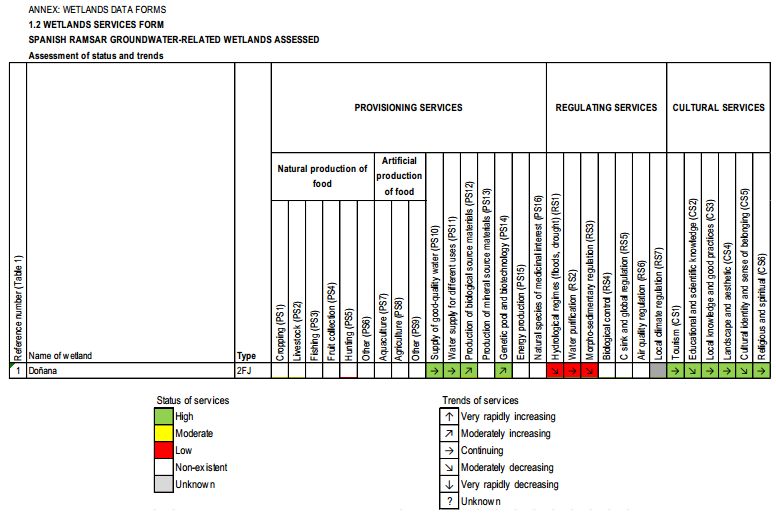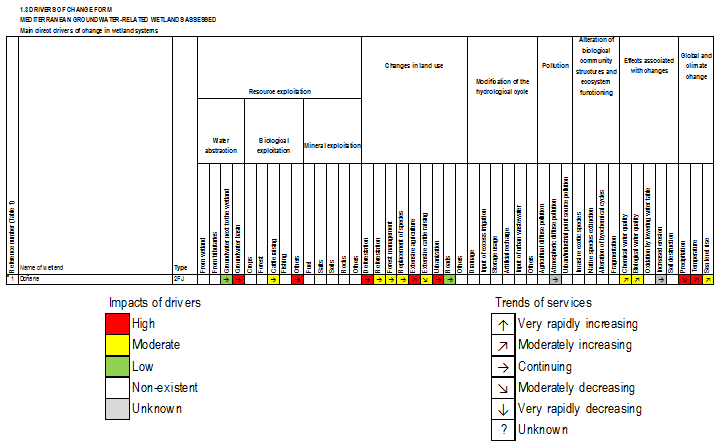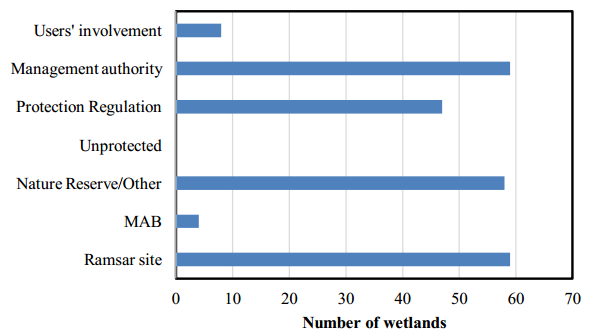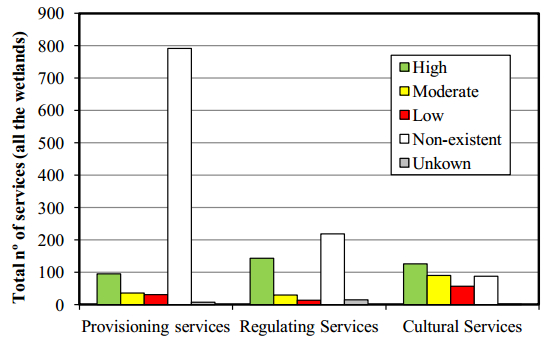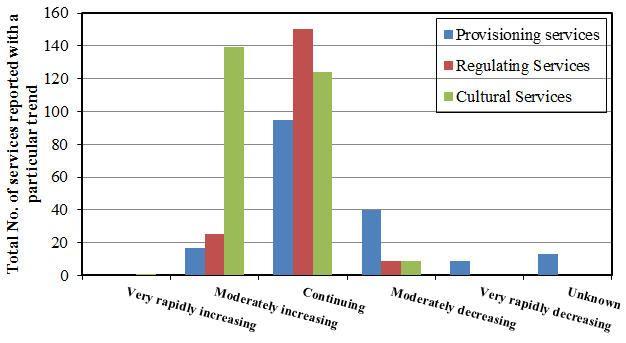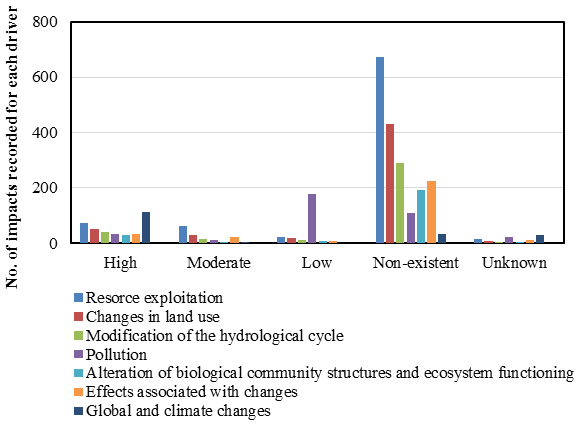1. Introduction
Many scientific papers deal with wetland hydrology and hydrogeology, but very little research has focused on characterizing the role of groundwater in wetlands from an ecosystem services approach [1,2]. Within the context of human wellbeing, ecosystems can be considered as "natural capital" providing humans with ecosystem services. The ecological integrity of ecosystems implies maintaining the functional features and structure of the ecosystem, as well as its capacity to recover from disturbance (ecological resilience) [3]. Ecological processes in a healthy ecosystem support its capacity to provide ecosystem services, which are related to human wellbeing improvement. Many wetlands are groundwater-related and most are partially or entirely dependent on it, so that any action related to groundwater exploitation may affect how the wetlands function or even whether they continue to exist [4]. Groundwater is a key component of how wetlands function and supports the performance of ecological processes, and therefore the ecosystem services they provide [5,6].
The Millennium Ecosystem Assessment [1,2] defines ecosystem services as "the benefits people obtain from ecosystems". These include provisioning services such as food and water; regulation and support services including regulating floods, droughts, land degradation and diseases, soil formation and nutrient cycling; and cultural services including recreation and spiritual, religious and other non-material benefits.
Drivers of change cause shifts in the ecological status of ecosystems and their service capacity. Degradation and loss of wetlands occurs more quickly than in other ecosystems. Similarly, the status of both freshwater and coastal wetland species deteriorates faster than those of other ecosystems. The direct and indirect drivers of this degradation are mostly associated with human activities. Direct drivers affect the ecosystems concerned directly. In the case of wetlands, these include infrastructure and urban development, land conversion, water withdrawal or disposal, eutrophication and pollution, overharvesting and overexploitation, and the introduction of invasive alien species [1]. Indirect drivers affect ecosystems indirectly through their results, which include population growth, increasing economic activity and development, and climate change.
Spain has currently around 114, 000 ha of wetlands, 98, 000 of them corresponding to coastal wetlands and 16, 000 of inland wetlands [9]. There are 74 Spanish wetlands recognized as Ramsar sites (303 ha) [10], although according to previous studies, as [11] and [12], explained in the Materials and Methods, only 59 of them present interactions with aquifers.
There is a high interest in knowing the benefits that wetlands provide to society but an important effort has to be done to get and improve knowledge. This paper tries to contribute to this line of research, in order to support the ecosystem valuation either for end-users, the stakeholders or the general society.
Thus, the aim of this paper is to evaluate the main geological and hydrogeological characteristics, ecological services and drivers of change affecting 59 groundwater-related Spanish wetlands included in the Ramsar Convention. Hereinafter, a summary of the projects which provide previous experience on ecosystem services assessment is presented.
1.1. Millennium ecosystem assessment
The Millennium Ecosystem Assessment (MEA) is a large scale project which meets the need to analyze the relationship between human wellbeing and ecosystem services. This international project launched in year 2000 a two-year international scientific program involving more than 1300 researchers from 95 countries. The project assessed the conditions and conservation trends of Earth's ecosystems and how they relate to human wellbeing through the benefits or services that these ecosystems provide [1,2]. The results of this project make clear how ecosystems affect human life, and highlight the need to improve awareness of their important role of enhancing our wellbeing.
1.2. Ecosystem studies of groundwater-related wetlands
1.2.1. The Ecomilenio project
The MEA was implemented in Spain in the Evaluación de los Ecosistemas del Milenio de España (EME), usually abbreviated as Ecomilenio project, promoted by the Biodiversity Foundation and the Ministry for the Environment and carried out in 2009-2011 by 60 researchers from 20 institutions. The EME [13] was the first attempt to understand the complex interactions between nature and society in Spain. It started from the hypothesis that if the ecosystems and biodiversity in Spain can be empirically demonstrated to be the basis of our livelihood, this could solve the traditional dialectical conflict seeking a "balance between conservation and development" that dominates conventional conservationist forums and political discourse, through the paradigm of " conservation of ecosystems and biodiversity for human wellbeing". Wetlands are included in the fourteen ecosystem types studied in the EME project. The main project results include that (1) the loss and/or transformation of wetlands in the mid to long-term compromise the services they provide to society, (2) the Spanish wetlands provide various provisioning services, especially good-quality water supply and provision of food and biological materials, (3) Spanish wetlands also provide a long list of regulating services, although not at a regional or global scale due to their small size, (4) wetlands provide cultural services which are a main identifying feature, and (5) this type of ecosystem is very sensitive to direct drivers of change, as changes in surrounding land use. The direct result of the shift from extensive traditional agriculture to that based on irrigation and mechanization has been the drying out and cultivation of many wetland surfaces. The indirect result of this change has been to deprive the wetlands of their water contribution due to exploitation of aquifers, channeling and/or regulation.
1.2.2. The IGCP project N° 604
The international project "Groundwater and wetlands in Ibero-America" (IGCP project 604) was carried out under the auspices of the UNESCO International Geological Correlation Programme, in the period 2011-2015, under the leadership of Dr. Emilia Bocanegra, of the Universidad Nacional de Mar del Plata (Argentina). The project goal was to analyze the relationship between wetlands and wellbeing in Ibero-America (represented by Argentina, Bolivia, Brazil, Chile, Colombia, Costa Rica, Dominican Republic, Ecuador, México, Nicaragua and Uruguay) and Spain. The results have been published [14,15].
1.2.3. The GEF/UNESCO-IHP MedPartnership Project
The GEF/UNESCO-IHP MedPartnership Project was one of the activities carried out within Subcomponent 1.1 "Management of Coastal Aquifers and Groundwater" of the UN Global Environmental Facility (GEF) project Strategic Partnership for the Mediterranean Sea Large Marine Ecosystem (MedPartnership). The activity was "Implementation of eco-hydrogeological applications for management and protection of coastal wetlands". The Sub-component 1.1 was led by the UNESCO-International Hydrological Programme (IHP). The project goal was threefold, to produce: (1) A Regional Report entitled Management and protection of Mediterranean groundwater-related coastal wetlands and their services. (2) A Technical Report entitled Main hydro (geo) logical characteristics, ecosystem services and drivers of change of 26 representative Mediterranean groundwater-related coastal wetlands; and (3) A Map showing Hydrogeological and ecosystem services classification of representative Mediterranean groundwater-related wetlands.
This project was implemented in 26 groundwater-related coastal Mediterranean wetlands and the results have been published [16,17,18] and presented in different fora [19,20,21].
This paper benefits from the results and experience obtained from the participation of some of the authors in the above mentioned projects.
2. Materials and methods
The Spanish wetland ecosystems are very diverse due to the widely variable climatic, geologic, physiographic, hydrological, hydrogeological and landscape characteristics of the Iberian Peninsula. This provides to Spain the greatest diversity of inland aquatic ecosystems in Europe. Wetlands included in Ramsar Convention represent mostly environments different from the cold temperature of the most part of Europe, with a multitude of endorheic sites and temporary ecosystems, as well as unique and very specific flora and fauna [22].
2.1. Existing knowledge of Spanish Ramsar wetlands
There are 74 Spanish wetlands included in the Ramsar Convention (Figure 1). The level of research performed in these wetlands differs, as some are considered of international relevance whereas others are almost unknown.
Over the last fifteen years, research has been undertaken to provide the hydrogeological approach to understanding these wetlands. Two of these studies are particularly relevant, as they deal with groundwater dependence, wetland genesis, hydroperiod, and wetland water hydrochemistry [11,12]. Study [11] provides the hydrogeological characterization of the first 49 Spanish wetlands included in the Ramsar Convention. Study [12] provides the hydrogeological characterization of the remaining 25 wetlands. Nevertheless, for the aim of this paper, only the groundwater-related Spanish Ramsar wetlands have been considered. They are shown in black in Figure 1.
Information on each Ramsar site in Spain is available online from the Ministry of Agriculture (www.mapama.gob.es). This includes useful information (FIR-Ficha Informativa Ramsar, in Spanish available at MAGRAMA, Ficha Informativa Ramsar (FIR) [24] on different aspects related to geographical, physical, social, ecological, hydrological, geological, climate descriptions, genetic conditioners, management status, land property, uses and impacts affecting the Ramsar site, research activities, educational activities, and management authority. This information has been processed as input data to complete the proformas described in the following section.
2.2. Methodology
The methodology applied follows the approach used in the United Nations Millenium Ecosystem Assessment [1,2] the Ecomilenio project [23], the IGCP-604 project [14,15], and the MedPartnership project [16,17,18]. Three chart forms or proformas were designed to collect the required data for the Spanish groundwater-related Ramsar wetlands which are shown in the Annexes: General data form (Annex 1.1); Assessment of status and trends (Annex 1.2); and Main direct drivers of change in wetland systems (Annex 1.3). The aims and content of each form are shown in the following subsections.
2.2.1. Data collection
The General Data form collects the following information on the wetland (see Annex 1.1) ordered in columns from left to right or set of columns:
• Reference number and Wetland name;
• General type of wetland.
• Local climate, which considers four parameters: average rainfall (mm/year), average temperature (℃), average evapotranspiration (mm/year), and seasonality (high/low).
• Underlying lithology, which includes seven categories: siliceous sediments, carbonated sediments, carbonate rocks, evaporitic rocks, metamorphic rocks, volcanic rocks, and intrusive rocks.
• Morphometry, according to five parameters: surface area (km2), elevation (m asl), depth (m), length (m), and width (m).
• Wetland genesis: tectonic, erosive, dissolution, volcanic, floodplain, delta/estuary, dune morphology, coastal sedimentation, and artificial.
• Wetland sediments defined by five descriptors: sandy, silty, clayey, organic-rich, and peat.
• Water source: rainfall on the wetland, basin runoff, deep groundwater, shallow groundwater, sea (tidal/waves), fluvial inundation, and artificial.
• Groundwater flow type, defined by the following categories: flow-through, recharge area, open discharge area, closed saline; closed fresh, crypto-wetland, and variable.
• Hydroperiod according to three descriptors: permanent, seasonal, and variable.
• Hydrochemistry defined by three parameters: electrical conductivity (EC, mS/cm), dominant ( > 50%) anion/anions, and dominant ( > 50%) cation/cations.
• Groundwater dependence defined as high, medium, and low, as in [11,12]; this descriptor was modified in [14,15,16,17,18] to be: dominant, shared, and secondary.
• Dominant vegetation: forest, shrubs, bushes, prairie, halophytic vegetation, and phreatophytic vegetation.
• Trophic state: oligotrophic, mesotrophic, eutrophic, and hypereutrophic.
• Functionality: almost unaltered, moderately altered, highly altered, and artificial.
• State of knowledge: validated hydrogeological conceptual model, numerical model, interpreted chemical/isotopic information, biological information, socio-economic information, water level monitoring, groundwater level monitoring, groundwater quality monitoring, hydrogeological studies, wetland evolution studies, climate change impact studies, global change impact studies, and information on wetland uses.
• Management status: Ramsar site, UNESCO Man and Biosphere (MAB) programme, natural reserve/other, unprotected, protection regulation, management authority, and user's involvement.
Data of seasonality, hydroperiod, hydrochemistry and groundwater dependence were consulted in existing sources as indicated in Section 2.1.
The Wetlands' Services form was designed to collect specific information on ecosystem services provided by the groundwater-related wetlands. Three main groups of ecosystem services are considered: Provisioning (products obtained from ecosystems), Regulating (benefits obtained from regulation processes), and Cultural (non-material benefits obtained from ecosystems). Each main group consists of the following services:
Provisioning Services (PS1 to PS16 in Annex 1.2):
• Food: natural food production (PS1 to PS6) (cropping, fishing, hunting and livestock farming); and artificial food production (PS7 to PS9) (agriculture, aquaculture and other). The additional category "other" covers all other services non explicitly mentioned.
• Supply of good-quality water: water supply for human uses (PS10) including drinking water, irrigation, feedstock and industry (PS11). Production of biological source materials (PS12) including fiber, timber, organic matter, peat, microorganisms, vegetal and animal tissues. Production of mineral source materials (PS13) including salts, metals (pyrite, calcium, iron, etc.) clay and clay materials, sands, stromatolites, etc.
• Genetic pool and biotechnology (PS14): genes for biotechnological purpose Energy production (PS15) including tidal, wind and solar power.
• Natural species of medicinal interest (PS16): aromatic, cosmetic and medicinal plants.
Regulating Services (RS1 to RS7)
• Hydrological regimes (RS1): including physical buffering against floods, protection from sea-level rise and storm effects in coastal areas (e.g. coastal wetlands, such as coastal river floodplains, play an important role in reducing the impact of floodwaters produced by storm events), mitigation of drought effects, recharge and discharge, and others.
• Water purification (RS2): pollutant retention, transformation and removal, improved water quality.
• Morpho-sedimentary regulation (RS3): soil and sediments retention and export.
• Biological control (RS4): including habitats for resident or transient species, preservation of ecological interactions (e.g. pollination, trophic linkage) and biological diversity, resistance to invasive species, discharge, other.
• Carbon sink and global regulation (RS5): carbon sequestering and release.
• Air quality regulation (RS6): oxygen generation, chemical composition of the atmosphere, greenhouse gas retention.
• Local climate regulation (RS7): influence on local temperature, precipitation, and other meteorological variables.
Cultural Services (CS1 to CS6)
• Tourism (CS1): nature, leisure, and recreational activities linked to natural areas.
• Educational and scientific knowledge (CS2): tools for education and training, information source for the advancement of science.
• Local knowledge and good practices (CS3): maintaining traditional knowledge of sustainable exploitation and natural resources.
• Landscape and aesthetic (CS4).
• Cultural identity and sense of belonging (CS5): identity from perceiving wetlands as local heritage.
• Religious and spiritual (CS6): source of inspiration, sacredness, and seat of spiritual values.
In the MEA terminology Drivers of change are factors leading to direct changes in how wetlands function. To evaluate them, the following seven main categories and subcategories (particular drivers within each main group) have been used, considering the information available in the FIR sheets and the authors experience and knowledge of these wetlands (see Annex 1.3):
(1) Resource exploitation: sustainability level of the maintenance/non-maintenance of the wetland ecological integrity because of exploitation. Three main sources:
-Water abstraction: from the wetland, from tributaries, from groundwater next to the wetland, from basin groundwater
-Biological exploitation: crops; forest; cattle raising; fishing; others
-Mineral exploitation: fuel; salts; soils; rocks; others
(2) Changes in land use: capacity for maintaining ecological health or cause ecosystem loss. Nine drivers:
-Deforestation
-Reforestation
-Forest management
-Species replacement
-Extensive agriculture
-Extensive cattle raising
-Urbanization
-Roads
-Others
(3) Modification of the hydrological cycle: changes from the natural regime in terms of water quantity. Six drivers:
-Drainage
-Input of excess irrigation water
-Storage usage
-Artificial recharge
-Input of urban wastewater
-Others
(4) Pollution: changes in the physical, chemical and/or biological quality of wetland water, sediments and/or biota. Three drivers:
-Diffuse agricultural pollution
-Diffuse atmospheric pollution
-Urban or industrial pollution from specific sources
(5) Alterations in biological community structure and ecosystem functioning: changes in any ecosystem service provision. Four drivers:
-Invasive exotic species
-Native species extinction
-Alteration of biogeochemical cycles
-Fragmentation
(6) Effects associated with changes, as a result of other existing drivers. Five drivers:
-Changes in chemical water quality
-Changes in biological water quality
-Oxidation from lowered water table
-Increased erosion
-Soil destruction
(7) Global and climate changes, in patterns of these drivers. Three drivers:
-Rainfall
-Temperature
-Sea-level rise
2.2.2. Methodology used for evaluation
The General Data form is shown in Annex 1.1. The Ecosystem Services form is shown in Figure 2 (developed in Annex 1.2) and the Drivers of Change form is shown in Figure 3 (developed in Annex 1.3).
The evaluation reports the status of each service using a color code and the observed or forecast trend in the most probable scenario using arrows. The format and content of the ecosystem services form and the code used for the services evaluation are shown in Figure 2. The evaluation of the ecosystem services as high, moderate or low is the most critical point of the evaluation process. The criteria applied have considered the wetland functioning under the current management state, considering the above mentioned sources consulted, and the author's knowledge. An ecosystem services has been considered as "high" when the wetland functionality allows providing that service in a good level. It is considered "Moderate" when the wetland functionality is partly altered and the service cannot be provided properly. And finally, it is considered "low" when the wetland functionality does not allow carrying out that service.
Just as for the ecosystem services evaluation procedure, a color code and arrows have been used to evaluate the drivers of change in ecosystem services. The color shows the qualitative impact of changes promoted by each driver on wetland ecological integrity; the arrows show the forecasted impact of the driver in the most probable future scenario. The format and content of the drivers of change form and the code used to evaluate the drivers are shown in Figure 3.
Where the ecosystem services evaluation had already been carried out, as in the case of Doñana and Aigüamolls de l'Empordá [7], this was reviewed taking into account the updated information and improved methodology.
3. Results
3.1. General characteristics of the wetlands assessed
This section includes the analysis of a set of aspects selected from the Wetland General Data form shown in Annex 1.1, including wetland genesis, groundwater relationship, functionality, and management status.
There are two reasons for choosing these specific features rather than others: (a) they are the most important for determining the status of the ecological integrity of each wetland, and (b) the information is complete and available in all the wetlands evaluated, whereas other aspects, e.g., groundwater flow type, are generally unknown despite their importance in wetland functioning; or there is not enough information in FIR sheets for assessment, as e.g., the trophic status.
Wetlands genesis
The geological genesis considered is shown in Annex 1.1. Three main groups are differentiated: coastal wetlands (18), inland wetlands (38), and artificial wetlands (3). The first group includes 14 Mediterranean and 4 Atlantic wetlands associated with different environments (Figure 1). Most of the inland wetlands (23) are linked to dissolution processes derived from karstic or evaporitic karst environments; these wetlands are mostly in Campiña in Andalusia, southern Spain; they are linked to processes which are glacial (3), fluvial (10), structural (1) or tectonic, volcanic (1) and all of them are well reflected in the General Data form and characterized in [11,12].
Groundwater relationship
The groundwater influence is high or medium in most of the 59 wetlands considered in this study, confirming that groundwater is essential for the ecological functioning of these ecosystems.
Functionality
The functionality of most of the wetlands is reported as altered to different degrees: moderately altered (46), almost unaltered (6), highly altered (4), and artificial (3).
Management status
All 59 wetlands considered in this study have some type of protection, not just as a Ramsar site, but with other national or regional regulations. All of them are significantly protected as nature reserves (Figure 4). Under Spanish Law 42/2007, the exploitation of resources is therefore limited in these reserves, with some exceptions in those cases where it is compatible with the conservation of the observed values. 47 wetlands are protected by regulations included in the Natural Resources Organization Plan or the Management and Use Guidance Plan, and 9 have their own management authority. 3 of the wetlands have some type of "users" involvement (Annex 1.1 Part 2).
3.2. Services provided by the evaluated wetlands
The results for services provided by the Spanish Ramsar wetlands are presented below in two sections. The first section describes the compared performance status reported for the three main types of ecosystem services considered: provisioning services, regulating services and cultural services. The second section describes the compared evolution trends of the three main types of ecosystem services considered.
3.2.1. Compared performance status of the three main types of ecosystem services considered
An assessment of the ecosystem services provided by each wetland is shown in Annex 1.2. The results of this analysis are shown in Figure 5. The performance level of many services in all wetlands is reported as high. For a slightly higher number of services this performance level is reported as moderate. For the lowest number of the three main types of services the performance level is reported as low. Figure 6 shows the specific services within the three main types reported as non-existent. This figure show the specific services within the three main types which do not take place in the current management state of the wetland. Perhaps some of the services could be delivered in other management scenario but not today such as it is being managed.
The results highlight that most of the provisioning, regulating and cultural services evaluated occur at low level in all the wetlands considered.
3.2.2. Compared evolution trends of the three main types of ecosystem services considered
The following main results are obtained by comparing the reported performance evolution trends of the three main types of ecosystem services considered for the whole set of wetlands considered (Figure 7).
None of the wetlands present provisioning, regulating and cultural services at a performance level reported as very rapidly increasing. A small number of services present a performance level reported as moderately increasing with the exception of cultural services in practically all cases. In most cases, most of the three types of services present a performance level reported as continuing with regulating services reported at this level. A few services present a performance level reported as moderately decreasing or very rapidly decreasing, with provisioning services reported at these levels in most cases.
The main conclusion on the observed or forecasted service trends evolution is that in most of the wetlands assessed there is no change in the performance level of most ecosystem services considered.
3.3. Drivers of change in the evaluated wetlands
Comparison of impacts reported for the main drivers of change considered
The compared impact levels of the seven main drivers of change considered are shown in Figure 8. The most frequently reported result for almost all driver types is non-existent. The drivers most often reported as non-existent refer to the main category Resource exploitation, followed by Changes in land use, and Modification of the hydrological cycle.
However, for Pollution and Global and Climate Change drivers of change, the impact levels low, medium, and high are more significant than non-existent. For the remaining five types of drivers of change, there are more cases where the impact is non-existent than where the impact is low, medium or high.
4. Discussion and conclusions
This paper attempts to analyze the relationship between groundwater-related wetlands of international importance in Spain, groundwater and human wellbeing. The method applied generates information on ecosystem services provided by the wetlands, the service trend, and the extent of the impacts affecting them and their evolution trend.
The three chart forms used to collect the information required are shown in the annex.
On a countrywide scale, the National Inventory of Wetlands prepared by the Ministry of Environment between 1988 and 1991 for the National Hydrological Plan is the only source of data on lakes and wetlands in Spain. Since then, the basin hydrological plans have provided the only updated data.
Other important discussion topics include the scarce presence of active public monitoring networks over the last ten years (since the onset of the economic crisis). However, in the academic field and other areas, apart from official management, ongoing research has continued to increase the hydrogeological understanding of many of the wetlands included in the Ramsar Convention. A considerable body of information is available on hydroperiods, groundwater contribution, evolution trends, etc. in doctoral theses and research project reports. Many reports have also been produced for the environmental departments of the regional authorities and central government Ministries by academy and other official and non-official institutions, although much of this information is dispersed and not easily accessible. The official management bodies should assign resources to collect this information and incorporate it into their management plans. The basin hydrological plans may also contribute to considerable improvement in this body of knowledge. But to date this information is not integrated into the FIR sheets prepared by the Ministry of the Environment. This is a limiting factor when analyzing and studying any aspect of this type of ecosystems.
In many cases, the ecosystem services are reported as non-existent (Figure 6). These results are extrapolated to the level of impact on the wetlands (Figure 8). This derives from the existing knowledge of the most common present-day situations of wetland functionality. Most FIR used date from 2006, with a few from 2012. Besides, data contained in the FIR are obsolete and the information provided by the FIR sheets clearly does not include data provided by the basin hydrological plans, which contain updated hydrological data on the current knowledge of each specific wetland.
The main conclusions reached on general features of the Spanish groundwater-related wetlands included in the Ramsar Convention evaluated using available FIR data are:
• Wetlands genesis: the two main groups of wetlands are coastal wetlands and inland wetlands, which include artificial wetlands. In most cases a set of processes contributes to the wetland genesis, although in most wetlands a dominant process can be defined. Most of the inland wetlands are associated with dissolution processes, related to either carbonate or evaporitic environments.
• Groundwater dependence: most wetlands present a shared participation of surface and groundwater, and many present a high groundwater influence.
• Wetland functionality: most wetlands are reported as moderately altered. Just four wetlands have been defined as almost unaltered corresponding to those in high mountain environments.
• Groundwater flow type: very little information is available on the groundwater flow type, which is one of the most important aspects to consider in water planning and wetland management. Obtaining this information is expected to be one of the main objectives of water authorities in the coming years.
• Trophic status: apart from a few exceptions, information on the trophic status is not available, although this data may be included in specific dispersed studies.
• Hydroperiod: 36 wetlands are permanent and 23 seasonal, some displaying a variable pattern.
• Current state of knowledge: a significant number of ecological studies have been carried out in most of the wetlands, although the information available on hydrogeological aspects is scarce, so further research is required to obtain a full picture of the specific situation of each wetland.
• Management status: all the wetlands considered have different protection conditions. However, this is no guarantee of adequate understanding and management, appropriate to the ecological status of the system.
• Ecosystem services: a significant number of the ecological services recognized in the wetlands considered are provided at a high level. However, this contrasts with the large number of services identified as non-existent or the small number identified as unknown.
• Evolution trend: the ecosystem service trend is recognized as predominately continuing, indicating that there is no change in the performance level of most of the ecosystem services assessed.
• Degree of impact comparison of the seven main types of drivers of change considered in this paper: non-existent is the most frequently reported result for almost all driver types. Most drivers reported as non-existent are related to Resource exploitation, followed by those related to Changes in land use and by those related to Modification of the hydrological cycle.
The results obtained provide a current picture of the Ramsar wetlands of Spain, and of the effort done in characterizing wetlands functioning and ecosystem services they provide. They try to make clearer and to enforce the strong relationships existing between groundwater flows, wetlands services and human well-being, as have been recognized in previous projects, literature and reports. However, the lack of information on specific aspects of wetlands uses and management restrictions could support the need of deeper analyses and assessment in the future. In this line, this is only a first approach, susceptible to be improved in the future with new data.
Finally, the authors wish to promote the discussion of two questions: (a) How to consider, in the future, a new driver of change relating to variations in geological aspects such as sedimentation rates or tuff growth; these abiotic factors may also cause direct changes in how the ecosystem functions. (b) How to define "impact". Impact is generally accepted as a set of effects caused by an event or fact in a physical or social environment. However, when applying this concept, it is not clear if these effects are positive or negative. In the applied methodology, the impacts are classified as high, medium and low, but there is no reference to how these impacts differ in each case. Therefore, the concept of positive or negative impact should be considered. The impact can be dealt with as a risk derived from a hazard.
Acknowledgements
The authors thank to Marisol Manzano and Antonio Camacho their role and contribution to MedPartnership Project which has been a key reference for this paper. Also to M. Núñez-Mezquita, S. A. Jorcano-Lange, M. Hernández-Paredes and E.C. Carrero-Carralero, who have collaborated in data processing and figures. The views expressed by the authors are not necessarily those of the institutions to which they belong. The authors also thank the two anonymous reviewers for their comments and remarks which have significantly help to improve this manuscript.
Conflict of interest
The authors declare there is no conflict of interest.









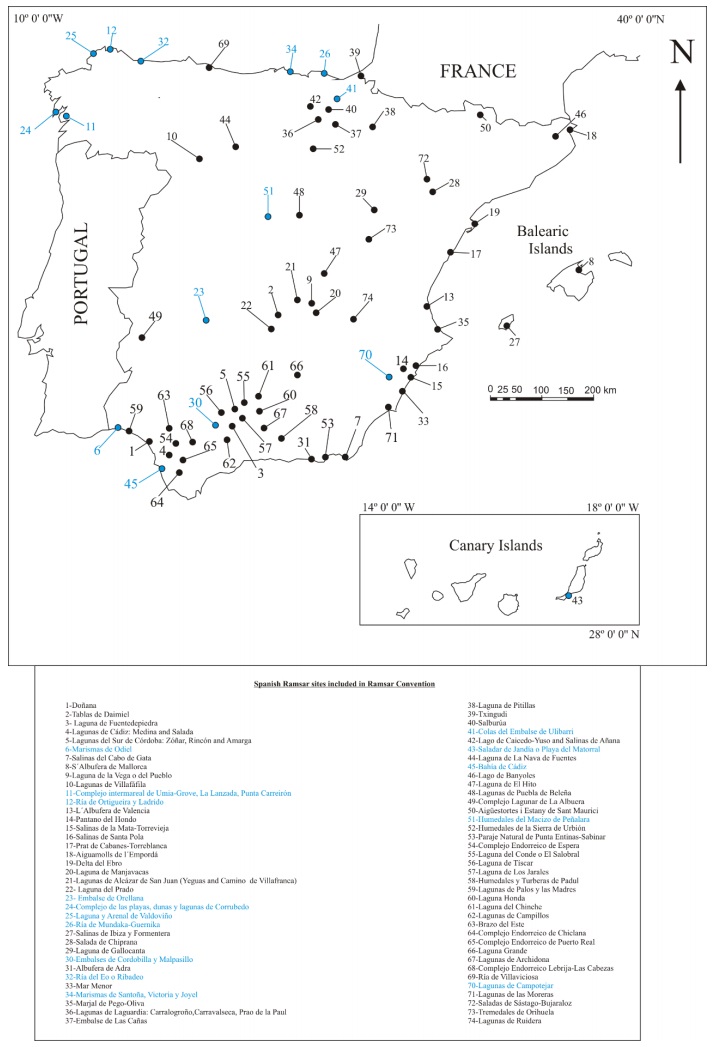
 DownLoad:
DownLoad: 